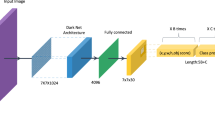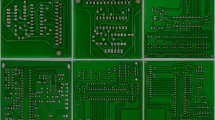Abstract
In modern industrial settings, the identification of chips on PCB boards is crucial for quality control and efficiency. However, achieving both speed and accuracy in chip detection remains a significant challenge. To address this issue, we propose the YOLO-GSG deep network model, which incorporates several novel modifications to the standard YOLO architecture. The key innovations include the replacement of the ELAN module with the C3Ghostnet module in the backbone network, improving feature extraction and reducing model complexity, and the introduction of the SE attention mechanism to minimize feature loss. Additionally, the GSnet module and GSConv convolution are integrated into the neck network to enhance feature fusion. The experimental results indicate that the YOLO-GSG algorithm achieves a mAP of 99.014%, with precision and recall improvements of 1.080% and 1.446% over the baseline YOLOv7 model. Additionally, the improved model has 24.478M parameters, 61.4 GFLOPs, and a model size of 50.8 MB. The model achieves an FPS of 231.55, representing a 12.8% speedup over the baseline. These results indicate that the YOLO-GSG model offers a superior balance of speed and accuracy for chip identification in industrial applications. This study contributes to the advancement of deep learning applications in industrial environments, providing a more efficient and effective tool for quality control in PCB manufacturing.












Similar content being viewed by others
Data availability
No datasets were generated or analysed during the current study.
References
Zheng, L.J., Zhang, X., Wang, C., Wang, L., Li, S., Song, Y.X., Zhang, L.: Experimental study of micro-holes position accuracy on drilling flexible printed circuit board. In: 11th Global Conference on Sustainable Manufacturing, Berlin, Germany. 268–272 (2013). https://doi.org/10.14279/DEPOSITONCE-4784
Ke, Y.J.: Research on PCB component positioning and identification technology. Nanjing University of Science and Technology, M.A (2017)
Fan, C.H.: Implementation of printed IC chip character recognition system based on heterogeneous platform. Shanghai University, M.A (2022)
Kerdvibulvech, C.: Human hand motion recognition using an extended particle filter. In: Perales, F.J., Santos-Victor, J. (eds) Articulated Motion and Deformable Objects. AMDO 2014. Lecture Notes in Computer Science, vol 8563. Springer, Cham. https://doi.org/10.1007/978-3-319-08849-5_8
Kerdvibulvech, C.: Hand tracking by extending distance transform and hand model in real-time. Pattern Recognit Image Anal. 25, 437–441 (2015). https://doi.org/10.1134/S1054661815030098
Zhang, L., Zhang, S.H., Yan, S., Yuan, Y.: Deep learning-based object detection and robotic arm grasping. J Xian Polytech Univ. 38(4), 65–72 (2024). https://doi.org/10.13338/j.issn.1674-649x.2024.04.009
Wang, Y., Yang, G., Guo, J.: Vehicle detection in surveillance videos based on YOLOv5 lightweight network. Bull. Polish Acad Sci. Tech. Sci.. 70(6), 43644 (2023). https://doi.org/10.24425/bpasts.2022.143644
Zhang, J.Y., Jing, J.F.: Defect classification of chopped strand mats based on deep learning and piecewise linear interpolation. J Xi’an Polytech Univ. 32(5), 553–559 (2018). https://doi.org/10.13338/j.issn.1674-649x.2018.05.011
Ding, R., Dai, L., Li, G., et al.: TDD-Net: a tiny defect detection network for printed circuit boards. CAAI Trans. Intell. Technol. 4, 110–116 (2019). https://doi.org/10.1049/trit.2019.0019
Wu, L., Zhang, L., Zhou, Q.: Printed circuit board quality detection method integrating lightweight network and dual attention mechanism. IEEE Access. 10, 87617–87629 (2022). https://doi.org/10.1109/ACCESS.2022.3198994
Zheng, J., Sun, X., Zhou, H., Tian, C., Qiang, H.: Printed circuit boards defect detection method based on improved fully convolutional networks. IEEE Access. 10, 109908–109918 (2022). https://doi.org/10.1109/ACCESS.2022.3214306
Yu, Z., Wu, Y., Wei, B., et al.: A lightweight and efficient model for surface tiny defect detection. Appl. Intell. 53, 6344–6353 (2023). https://doi.org/10.1007/s10489-022-03633-x
Wang, C.Y., Bochkovskiy, A., Liao, H.Y.M.: YOLOv7: trainable bag-of-freebies sets new state-of-the-art for real-time object detectors. In: 2023 IEEE/CVF Conference on Computer Vision and Pattern Recognition (CVPR). Vancouver, BC, Canada. pp. 7464–7475 (2023). https://doi.org/10.1109/CVPR52729.2023.00721
Zhu, X., Lyu, S., Wang, X., Zhao, Q.: TPH-YOLOv5: improved YOLOv5 based on transformer prediction head for object detection on drone-captured scenarios. In: 2021 IEEE/CVF International Conference on Computer Vision Workshops (ICCVW). pp. 2778–2788 (2021). https://doi.org/10.1109/ICCVW54120.2021.00312
Hu, J., Shen, L., Sun, G.: Squeeze-and-excitation networks. In: 2018 IEEE/CVF Conference on Computer Vision and Pattern Recognition. pp. 7132–7141 (2018). https://doi.org/10.1109/CVPR.2018.00745
Ding, X., Zhang, X., Ma, N., Han, J., et al.: RepVGG: Making VGG-style ConvNets Great Again. In: 2021 IEEE/CVF Conference on Computer Vision and Pattern Recognition (CVPR). pp. 13728–13737(2021). https://doi.org/10.1109/CVPR46437.2021.01352
Liang, Y.Q.: Research on edge learning based visual inspection system - character recognition and defect detection as an example. Liaocheng University, M.A (2023)
She, Y.T.: Single crystal silicon wire detection system based on Yolo algorithm. Lanzhou University, M.A (2024)
Zhang, X., Zhou, X., et al.: ShuffleNet: an extremely efficient convolutional neural network for mobile devices. In: 2018 IEEE/CVF Conference on Computer Vision and Pattern Recognition, Salt Lake City, UT, USA, 2018, pp. 6848–6856, https://doi.org/10.1109/CVPR.2018.00716
Howard, A.G., Zhu, M., Chen, B., Kalenichenko, D., Wang, W., Weyand, T., Andreetto, M., & Adam, H.: MobileNets: efficient convolutional neural networks for mobile vision applications. https://doi.org/10.48550/arXiv.1704.04861
K. Han, Y. Wang, Q. Tian, J. Guo, C. Xu and C. Xu,: GhostNet: more features from cheap operations, In: 2020 IEEE/CVF Conference on Computer Vision and Pattern Recognition (CVPR), Seattle, WA, USA, 2020, pp. 1577–1586, https://doi.org/10.1109/CVPR42600.2020.00165
Li, X., Yun, X., Zhao, Z., Zhang, K., Wang, W.: Lightweight deeplearning method for multi-vehicle object recognition. Inf. Technol. Control. 51, 294–312 (2022). https://doi.org/10.5755/j01.itc.51.2.30667
Jin, L., Yu, Y., Zhou, J., Bai, D., et al.: SWVR: a lightweight deep learning algorithm for forest fire detection and recognition. Forests 15(1), 204 (2024). https://doi.org/10.3390/f15010204
Hu, J., Wang, Z., Chang, M., Xie, L., Xu, W., Chen, N.: PSG-Yolov5: a paradigm for traffic sign detection and recognition algorithm based on deep learning. Symmetry. 14(11), 2262 (2022). https://doi.org/10.3390/sym14112262
Su, T., Wang, Y., Deng, QY., et al.: Improved pedestrian and vehicle detection algorithm in foggy weather based on YOLOv5. J Syst Simul. pp 1–11 (2024)
Li, M., Chen, S., Sun, C., Fang, S., Han, J., et al.: An improved lightweight dense pedestrian detection algorithm. Appl. Sci. 13(15), 8757 (2023). https://doi.org/10.3390/app13158757
Tang, Y., Han, K., Guo, JY., et al.: GhostNetV2: enhance cheap operation with long-range attention. https://doi.org/10.48550/arXiv.2211.12905
P. K. A. Vasu, J. Gabriel, J. Zhu, O. Tuzel and A. Ranjan, : MobileOne: An Improved One millisecond Mobile Backbone.: 2023 IEEE/CVF Conference on Computer Vision and Pattern Recognition (CVPR), Vancouver, BC, Canada, 2023, pp. 7907–7917, https://doi.org/10.1109/CVPR52729.2023.00764
Ma, N., Zhang, X., Zheng, HT., Sun, J.: ShuffleNet V2: practical guidelines for efficient CNN architecture design. Computer Vision – ECCV 2018. ECCV 2018. Lecture Notes in Computer Science, vol. 11218. Springer, Cham. https://doi.org/10.1007/978-3-030-01264-9_8
Howard, A. et al.: Searching for MobileNetV3. In: 2019 IEEE/CVF International Conference on Computer Vision (ICCV), Seoul, Korea (South), 2019, pp. 1314–1324, https://doi.org/10.1109/ICCV.2019.00140
Woo, S., Park, J., Lee, JY., Kweon, I.S.: CBAM: convolutional block attention module. In: Computer Vision – ECCV 2018:15th European Conference. vol. 11211 (2018). https://doi.org/10.1007/978-3-030-01234-2_1
Yang, L., Zhang, R., Li, L., Xie, X.: SimAM: a simple, parameter-free attention module for convolutional neural networks. Int. Conf. Mach. Learn.. 139, 11863–11874 (2021)
Wang, Q., Wu, B., Zhu, P., Li, P., et al.: ECA-Net: efficient channel attention for deep convolutional neural networks. In: 2020 IEEE/CVF Conference on Computer Vision and Pattern Recognition (CVPR). pp. 11531–11539 (2020). https://doi.org/10.1109/CVPR42600.2020.01155
Li, Y., Yao, T., Pan, Y., Mei, T.: Contextual transformer networks for visual recognition. IEEE Trans. Pattern Anal. Mach. Intell. 45(2), 1489–1500 (2023). https://doi.org/10.1109/TPAMI.2022.3164083
Acknowledgements
This work was supported by the National Natural Science Foundation of China (No.61971339), Basic Research Program of Natural Science of Shaanxi province (No.2022JM407), Innovation and Entrepreneurship training program for university students (No.S202310709041).
Author information
Authors and Affiliations
Contributions
Zeang Yue wrote the main text of the manuscript and carried out specific experimental studies, Xun Li provided theoretical guidance, revised the paper, and provided experimental equipment, Huilong Zhou participated in some of the experiments and reviewed the article, Gaopin Wang and Wenjie Wang provided ideas and theoretical guidance for the paper, and all of them reviewed the first draft.
Corresponding author
Ethics declarations
Conflict of interest
The authors declare no competing interests.
Additional information
Publisher's Note
Springer Nature remains neutral with regard to jurisdictional claims in published maps and institutional affiliations.
Rights and permissions
Springer Nature or its licensor (e.g. a society or other partner) holds exclusive rights to this article under a publishing agreement with the author(s) or other rightsholder(s); author self-archiving of the accepted manuscript version of this article is solely governed by the terms of such publishing agreement and applicable law.
About this article
Cite this article
Yue, Z., Li, X., Zhou, H. et al. Real-time recognition method for PCB chip targets based on YOLO-GSG. J Real-Time Image Proc 22, 44 (2025). https://doi.org/10.1007/s11554-024-01616-4
Received:
Accepted:
Published:
DOI: https://doi.org/10.1007/s11554-024-01616-4




